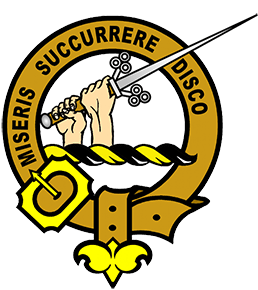MacMillan Clan
MacMillan Clan Crest: Two hands holding aloft a large sword.
MacMillan Clan Motto: Miseris Succurrere Disco (I learn to succour the unfortunate).
History of Clan MacMillan:
The surname in Gaelic means “Son of the bald one,” and Malcolm Mor Macmillan appears in Knapdale with a Charter from the Lord of the Isles in 1360. Prior to this, the Clan is said to have evolved from the
northern Pictish tribe, the Kanteai.
In the 12th century, when David I allocated swathes of land to his Norman friends, the MacMillans moved to Lochaber. When Robert the Bruce went into hiding following the murder of the Red Comyn in 1306, he was given shelter at Ben Lawers by Maolmuir, the MacMillan Chief. Maolmuir's brother Gilbert is thought to be the ancestor of the MacMillans of Brockloch in Galloway.
The Clan fought for Bruce at the Battle of Bannockburn in 1314, and thereafter followed the MacDonald Lords of the Isles, who granted them lands at Knapdale. At the beginning of the 16th century, when the Lordship of the Isles was terminated, the MacMillans gave allegiance to the replacement Lairds of Lochaber, the Camerons of Locheil. In the century that followed, many MacMillan clansmen moved to the south of Kintyre, or relocated on Arran, Jura and Colonsay.
Meanwhile, the Galloway MacMillans prospered and soon spread into Ayrshire and Kirkcudbrightshire. In 1742, Duncan MacMillan of Dunmore, whose lands were beside Loch Tarbert, was recognised by the Lord Lyon King of Arms as Chief of MacMillan, “representing the ancient family of Knapdale.”
With the death of Alexander MacMillan in 1770, the Chiefship passed to his cousin's son Duncan. In 1952, Lt General Sir Gordon MacMillan of MacMillan and Knap, a descendant of Duncan's brother William, was recognised by the Lord Lyon King of Arms as Chief. The Clan MacMillan Centre was opened at Finlaystone House, Langbank in Renfrewshire in 1991.
John MacMillan (1670-1753) was founder of the Reformed Presbyterian Church.
Alexander MacMillan (1818-96) founded the publishing firm MacMillan & Co, London. Kirkpatrick MacMillan (1812-1878) invented the two-wheeled velocipede (bicycle). Hugh MacMillan (1873-1952) became
Lord Advocate in 1924, and Lord MacMillan of Aberfeldy in 1930 He served as UK Minister of Information from 1939-40. Sir Harold MacMillan (1894-1986) was UK Prime Minister from 1957-63. He was created Earl of
Stockton. Sir Kenneth MacMillan (1929 - 1992) was Principal Choreographer of the Royal Ballet.
Surname distribution in Scotland: The MacMillan name is most common in The Western Isles (the main islands include Lewis and Harris, North Uist, South Uist, Benbecula and Barra), Highland (an amalgamation of the historic counties of Caithness, Inverness-shire, Nairnshire, Ross and Cromarty and Sutherland), Perth and Kinross, Argyllshire, Ayrshire and Renfrewshire.
Places of Interest: Castle Sween, Knapdale, Argyll. Castle built by the 12th Chief of MacMillan and held for the Lords of the Isles. Now a ruin.
Kilmory, Knapdale, Argyll. The small 13th century chapel is situated on the Eastern side of Loch Sween .
Loch Killisport has a 15th century Macmillan's Cross.
Keir, Sanquhar, Dumfriesshire. Birthplace of Kirkpatrick Macmillan who built the first pedal bicycle.
Clan MacMillan Centre, Finlaystone House, Langbank, Renfrewshire. Seat of the MacMillan Chief. It was the home of the Cunningham earls of Glencairn for 400 years, and in 1897 was acquired by a Glasgow shipping tycoon George Kidston, from whom it passed to his granddaughter, wife of General Sir Gordon MacMillan of MacMillan and Knap.
Associated family names (Septs): Baxter, Bell, Blue, Broun, Brown, MacBaxter, MacNamell.
Clan MacMillan membership prints.

